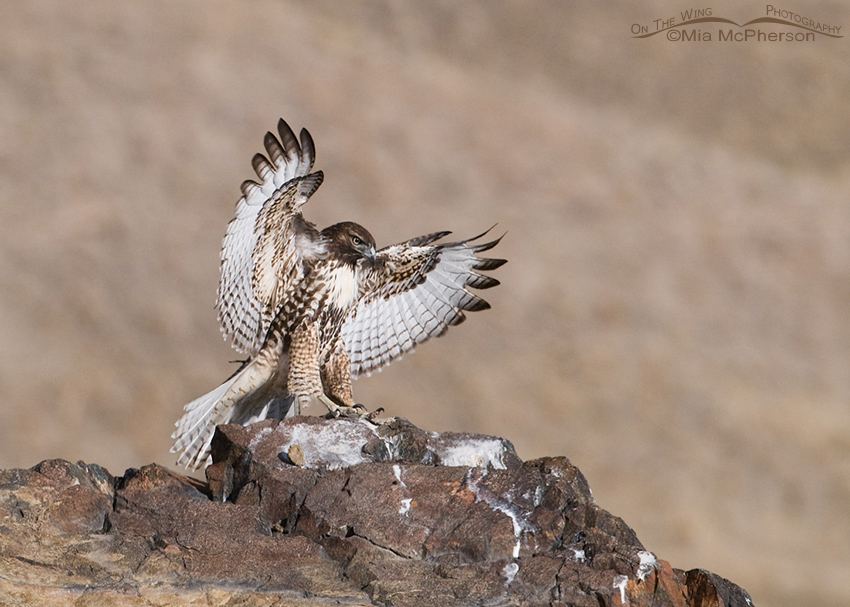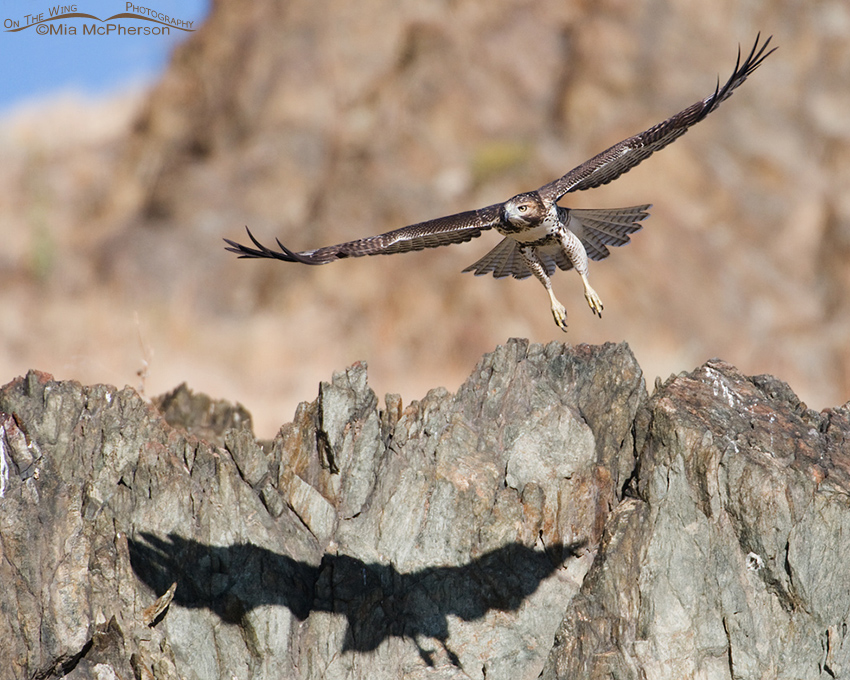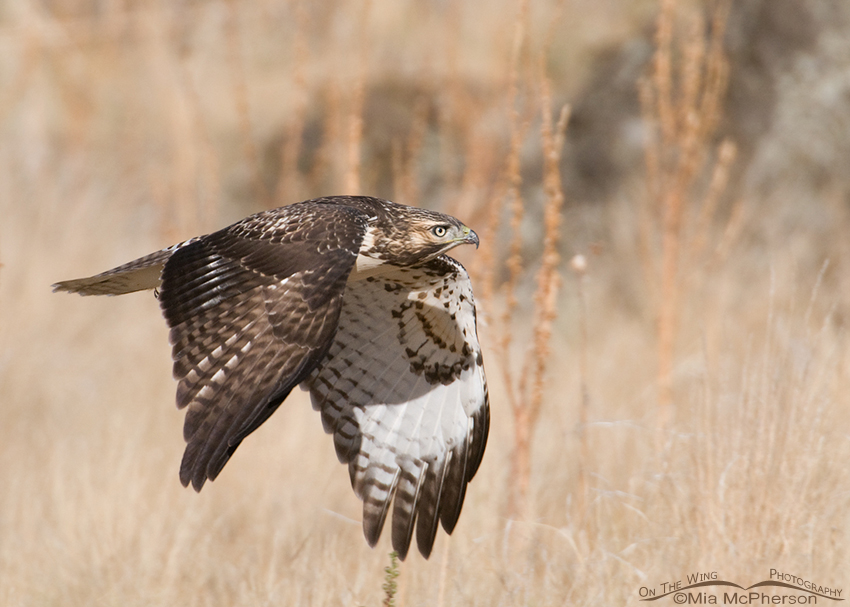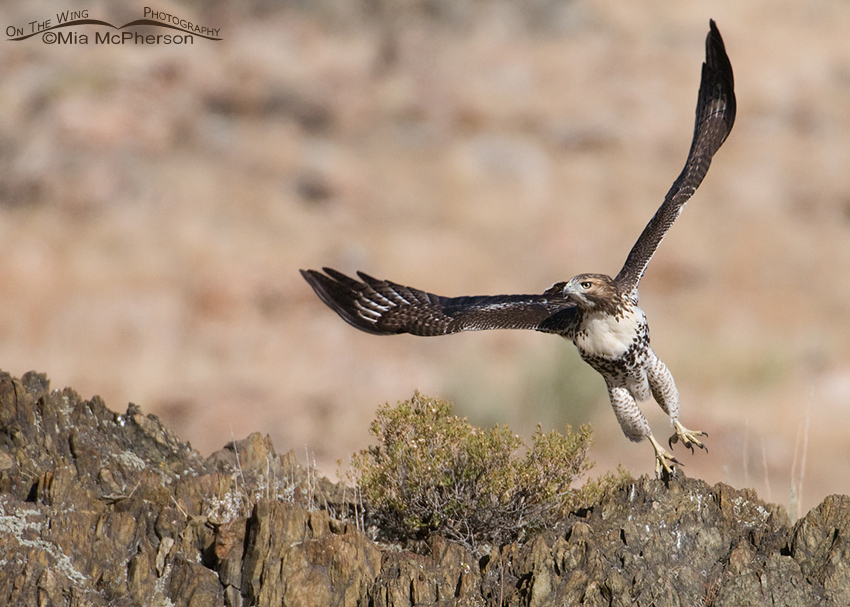 Red-tailed juvenile landing on a rock outcropping – Nikon D300, f6.3, 1/2000, ISO 640, Nikkor 200-400mm VR with 1.4x TC at 300mm, natural light, not baited
Red-tailed juvenile landing on a rock outcropping – Nikon D300, f6.3, 1/2000, ISO 640, Nikkor 200-400mm VR with 1.4x TC at 300mm, natural light, not baited
These are a just few images that I have edited taken since August of Red-tailed Hawk juveniles on Antelope Island State Park.
The juvenile Red-tailed above was just coming in to land on a rocky out cropping, the white wash is a sign that this rock is used as a perch often and not just by the Red-tailed Hawks. I’ve seen American Kestrels, Chukars, Rock Wrens, Western Meadowlarks, and more on those rocks.
 Red-tailed Hawk juvenile and its shadow – Nikon D300, f6.3, 1/1250, ISO 640, +0.3 EV, Nikkor 200-400mm VR with 1.4x TC at 400mm, natural light, not baited
Red-tailed Hawk juvenile and its shadow – Nikon D300, f6.3, 1/1250, ISO 640, +0.3 EV, Nikkor 200-400mm VR with 1.4x TC at 400mm, natural light, not baited
Even though the young hawk is small in the frame in this image I like it because of the bird’s shadow falling on the rock below it.
 Red-tailed juvie flying past – Nikon D300, f6.3, 1/1600, ISO 500, +0.3 EV, Nikkor 200-400mm VR with 1.4x TC at 400mm, natural light, not baited
Red-tailed juvie flying past – Nikon D300, f6.3, 1/1600, ISO 500, +0.3 EV, Nikkor 200-400mm VR with 1.4x TC at 400mm, natural light, not baited
This immature Red-tailed Hawk was looking at the rock it would soon perch on as it flew past me.
 We have lift off – Nikon D300, f6.3, 1/2000, ISO 640, -0.3 EV, Nikkor 200-400mm VR with 1.4x TC at 400mm, natural light, not baited
We have lift off – Nikon D300, f6.3, 1/2000, ISO 640, -0.3 EV, Nikkor 200-400mm VR with 1.4x TC at 400mm, natural light, not baited
This Red-tailed juvenile was just lifting off from the dark rocks when I created this image, the talons on the bird’s right foot were still touching the perch it was leaving. This frame shows how long the legs of these Red-tailed Hawks actually are.
Life is good.
Mia
Click here to see more of my Red-tailed Hawk photos plus facts and information about this species.


Mia, that first photo (at the risk of anthropomorphizing which, sadly, I do) looks like a pose for a sermon. I’m so drawn to that image, I can’t stop looking at it.
I anthropomorphize at times too Ingrid. I can see the sermon pose too. Thanks so much for your comment.
A free spirit, that’s how I feel when looking at your raptors, all of them are great!
Thank you Maria.
Hi! You catch the in flight Photo’s in such a great way! The colors and feather patterns are so perfect. Keep up the beautiful work.
Thanks Mom!
Gorgeous photos of a really snazzy bird Mia; your work is always stunning!
Thank you Dan!
I absolutely love the lighting on your shots. That crystal sharp clear image as they lift off…..nice! Beautiful subjects to capture on camera.
Thank you Chris.
Spectacular! A beautiful bird, perfect images.
Thanks wally, they are such handsome birds
Wonderful shots!
Thank you Scott.
Nice juvie pix, Mia!
Thanks Jim.
what fabulous pictures…love it..
Thank you Syl!
Your collection of RT Hawk images is stunning, Mia. I love the landing photo. Looks like it’s conducting an orchestra down below.
Thanks Tami, I see what you mean about looking like it is conducting an orchestra.
They are indeed amazing creatures to watch and your shots are fabulously showing that!
Thank you Sherry!
Nice work Mia, seeing it so well photographed, makes it as brilliant as they say.
Thanks Bob, they are brilliant birds!
simply wonderfull, good job mia
Thank you Eric.
Speechless.
I love the shadow pic!
Thanks Judy!!